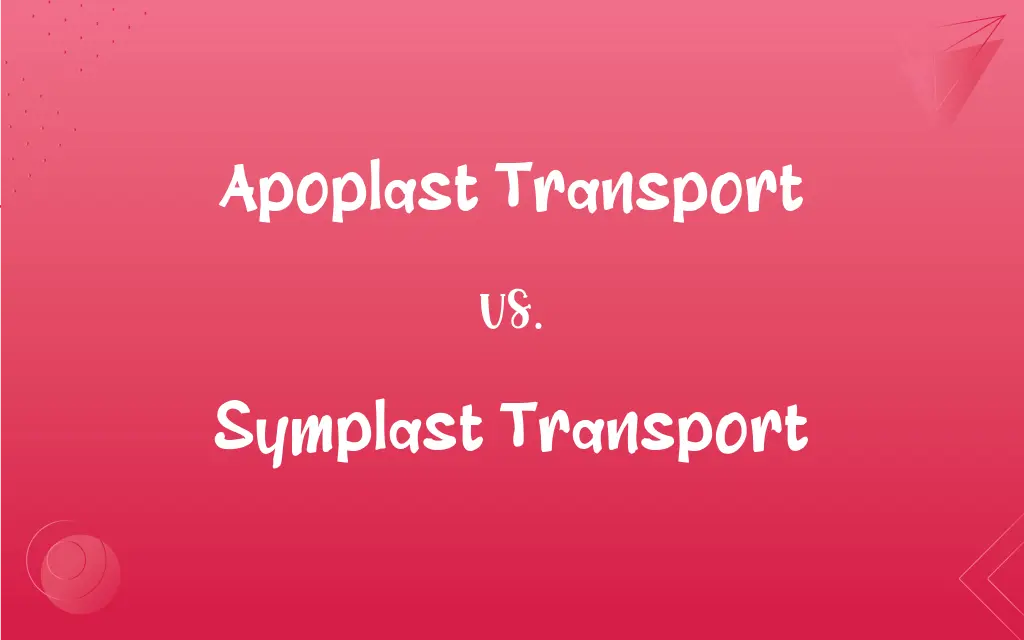Apoplast Transport vs. Symplast Transport: What's the Difference?
Edited by Aimie Carlson || By Harlon Moss || Updated on October 9, 2023
Apoplast transport involves water movement through plant cell walls and spaces, while symplast transport uses interconnected cytoplasms of cells via plasmodesmata.

Key Differences
In the realm of plant physiology, understanding how plants transport water and solutes is crucial. Apoplast transport is a method in which water, along with dissolved substances, moves through the cell walls and extracellular spaces of plants. This pathway does not involve the actual passage through living cells. Instead, it circumvents them, utilizing the spaces and channels between cells for the transport process. This passive transport is driven by gradients and can quickly convey substances.
On the other hand, symplast transport capitalizes on the interconnected nature of plant cells. Specifically, it uses the cytoplasm of adjacent cells connected by tiny channels called plasmodesmata. In this method, water and solutes travel from one cell's cytoplasm to another's, essentially using the living part of the cell for transport. This mode ensures selective transport and can be regulated based on plant needs.
Apoplast transport and symplast transport can be viewed as two highways facilitating the movement of water and solutes in plants. While the apoplast pathway might be compared to an external bypass around a city (the cells being the city), the symplast pathway is like roads within the city itself. Each serves a unique function, and both are essential for the plant's overall nutrient and water management.
Choosing between apoplast transport and symplast transport isn't up to the plant. Instead, both pathways work in tandem, complementing each other. The processes ensure efficient uptake and distribution of water and nutrients necessary for the plant's survival and growth.
Comparison Chart
Pathway
Through cell walls & spaces
Through interconnected cytoplasms
ADVERTISEMENT
Involves
Non-living parts of the plant
Living parts of the plant
Transport Type
Passive
Can be regulated
Speed
Generally rapid
Varies based on plant needs
Connection
Extracellular spaces
Plasmodesmata
Apoplast Transport and Symplast Transport Definitions
Apoplast Transport
A method bypassing the living cellular content.
Nutrient deficiencies can alter the efficiency of apoplast transport.
ADVERTISEMENT
Symplast Transport
Movement via plasmodesmata channels.
For controlled water movement, plants use symplast transport.
Apoplast Transport
Relies on gradients for movement of substances.
Apoplast transport helps maintain plant turgidity in optimal conditions.
Symplast Transport
Uses interconnected plant cell cytoplasms.
Symplast transport plays a role in selective nutrient absorption.
Apoplast Transport
Movement through plant cell walls and spaces.
Apoplast transport allows for rapid conveyance of water in plants.
Symplast Transport
Relies on living parts of plants for transport.
The symplast transport pathway can be regulated based on external stimuli.
Apoplast Transport
Utilizes non-living plant parts for transport.
In drought conditions, apoplast transport can be affected.
Symplast Transport
Ensures selective transport within plants.
To combat stress, plants might adjust symplast transport rates.
Apoplast Transport
Passive transport in plants avoiding living cells.
Apoplast transport aids in the quick uptake of water from the soil.
Symplast Transport
Involves the actual passage through living cells.
Cells communicate using symplast transport mechanisms.
FAQs
What substances are moved through apoplast transport?
Primarily water and solutes like minerals and nutrients.
Does apoplast transport involve crossing cell membranes?
No, apoplast transport does not involve crossing cell membranes, as it proceeds through the cell walls.
Can apoplast transport be influenced by external factors?
Yes, factors like transpiration rate and soil moisture can influence it.
Is energy required for symplast transport?
Yes, it can require energy, especially for the active transport of solutes.
Is energy required for apoplast transport?
No, apoplast transport generally does not require metabolic energy.
Does apoplast transport contribute to nutrient uptake?
Yes, it plays a significant role in transporting nutrients from the soil to plant cells.
What is symplast transport?
Symplast transport involves the movement of water and solutes through the cytoplasm of plant cells, connecting through plasmodesmata.
What substances commonly move through the symplast?
Water, sugars, ions, amino acids, and some hormones.
What is apoplast transport?
Apoplast transport involves the movement of water and solutes through the non-living parts of plants, such as the cell walls and intercellular spaces.
Is apoplast transport important in drought conditions?
Yes, it can be crucial in providing pathways for water movement when the soil is dry.
Is the apoplast involved in disease resistance?
Yes, it can act as a barrier to some pathogens.
How does apoplast transport interact with symplast transport?
Both pathways can work together to ensure efficient water and nutrient distribution throughout the plant.
Can symplast transport be regulated?
Yes, it can be regulated by modifying the permeability of plasmodesmata.
How does symplast transport support plant growth?
It helps in distributing nutrients and signaling molecules to regulate growth.
How is symplast transport different from apoplast transport?
Symplast transport involves movement through living cells and can require energy, while apoplast transport occurs through non-living cell walls and spaces and typically does not require energy.
Does symplast transport involve cell membranes?
Yes, initial uptake of substances into the symplast involves crossing a cell membrane.
What structures facilitate symplast transport?
Plasmodesmata, channels linking adjacent plant cells, facilitate this transport.
Is symplast transport influenced by environmental factors?
Yes, factors like light and temperature can impact it.
Does symplast transport have a direction?
It can be multidirectional, but is often sourced from sites of higher to lower solute concentration.
How is apoplast transport related to soil pH?
The pH of the soil can influence the solubility of nutrients, affecting their transport through the apoplast.
About Author
Written by
Harlon MossHarlon is a seasoned quality moderator and accomplished content writer for Difference Wiki. An alumnus of the prestigious University of California, he earned his degree in Computer Science. Leveraging his academic background, Harlon brings a meticulous and informed perspective to his work, ensuring content accuracy and excellence.
Edited by
Aimie CarlsonAimie Carlson, holding a master's degree in English literature, is a fervent English language enthusiast. She lends her writing talents to Difference Wiki, a prominent website that specializes in comparisons, offering readers insightful analyses that both captivate and inform.































































